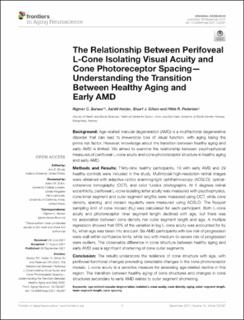| dc.contributor.author | Baraas, Rigmor C. | |
| dc.contributor.author | Horjen, Åshild Bøysen | |
| dc.contributor.author | Gilson, Stuart | |
| dc.contributor.author | Pedersen, Hilde R. | |
| dc.date.accessioned | 2022-02-09T13:17:40Z | |
| dc.date.available | 2022-02-09T13:17:40Z | |
| dc.date.created | 2021-10-12T16:44:38Z | |
| dc.date.issued | 2021 | |
| dc.identifier.citation | Baraas, R. C., Horjen, Å., Gilson, S. J. & Pedersen, H. R. (2021). The Relationship Between Perifoveal L-Cone Isolating Visual Acuity and Cone Photoreceptor Spacing—Understanding the Transition Between Healthy Aging and Early AMD. Frontiers in Aging Neuroscience, 13, Artikkel 732287. | en_US |
| dc.identifier.issn | 1663-4365 | |
| dc.identifier.uri | https://hdl.handle.net/11250/2978031 | |
| dc.description.abstract | Background: Age-related macular degeneration (AMD) is a multifactorial degenerative disorder that can lead to irreversible loss of visual function, with aging being the prime risk factor. However, knowledge about the transition between healthy aging and early AMD is limited. We aimed to examine the relationship between psychophysical measures of perifoveal L-cone acuity and cone photoreceptor structure in healthy aging and early AMD.
Methods and Results: Thirty-nine healthy participants, 10 with early AMD and 29 healthy controls were included in the study. Multimodal high-resolution retinal images were obtained with adaptive-optics scanning-light ophthalmoscopy (AOSLO), optical-coherence tomography (OCT), and color fundus photographs. At 5 degrees retinal eccentricity, perifoveal L-cone isolating letter acuity was measured with psychophysics, cone inner segment and outer segment lengths were measured using OCT, while cone density, spacing, and mosaic regularity were measured using AOSLO. The Nyquist sampling limit of cone mosaic (Nc) was calculated for each participant. Both L-cone acuity and photoreceptor inner segment length declined with age, but there was no association between cone density nor outer segment length and age. A multiple regression showed that 56% of the variation in log L-cone acuity was accounted for by Nc when age was taken into account. Six AMD participants with low risk of progression were well within confidence limits, while two with medium-to-severe risk of progression were outliers. The observable difference in cone structure between healthy aging and early AMD was a significant shortening of cone outer segments.
Conclusion: The results underscore the resilience of cone structure with age, with perifoveal functional changes preceding detectable changes in the cone photoreceptor mosaic. L-cone acuity is a sensitive measure for assessing age-related decline in this region. The transition between healthy aging of cone structures and changes in cone structures secondary to early AMD relates to outer segment shortening. | en_US |
| dc.language.iso | eng | en_US |
| dc.rights | Navngivelse 4.0 Internasjonal | * |
| dc.rights.uri | http://creativecommons.org/licenses/by/4.0/deed.no | * |
| dc.title | The Relationship Between Perifoveal L-Cone Isolating Visual Acuity and Cone Photoreceptor Spacing—Understanding the Transition Between Healthy Aging and Early AMD | en_US |
| dc.type | Peer reviewed | en_US |
| dc.type | Journal article | en_US |
| dc.description.version | publishedVersion | en_US |
| dc.rights.holder | © 2021 Baraas, Horjen, Gilson and Pedersen. | en_US |
| dc.source.volume | 13 | en_US |
| dc.source.journal | Frontiers in Aging Neuroscience | en_US |
| dc.identifier.doi | https://doi.org/10.3389/fnagi.2021.732287 | |
| dc.identifier.cristin | 1945432 | |
| dc.source.articlenumber | 732287 | en_US |
| cristin.ispublished | true | |
| cristin.fulltext | original | |
| cristin.qualitycode | 1 | |

